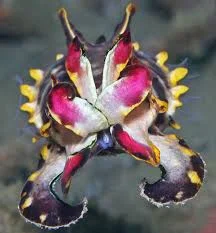Animal of the month - Flamboyant Cuttlefish
The flamboyant cuttlefish, or Metasepia Pfefferi, are mainly found in the Indo-Pacific waters off the coasts of Northern Australia as well as the numerous islands of the Philippines, Malaysia and Indonesia. We at Dive Central Gili have our very own little flamboyant on our house reef, the Bio Rocks. Only a few of us have been lucky to see him, but those who have appreciate even more just how spectacularly cool these little mollusks are.
Their name comes from their skull, called the cuttlebone. The cuttlebone is used to control their buoyancy. It is made of calcium carbonate and is divided into many chambers which the cuttlefish can fill or empty depending on it's buoyancy needs. When a cuttlefish dies, their skulls, or cuttlebones, are often found washed up on the beaches and tend to be collected by passers by. You may also see them sold as a supplement treat for domesticated birds.
As colorful as he is poisonous, (it was only recently that scientists found them to be just as poisonous as a blue ringed octopus!) the flamboyant cuttlefish lives up to it's name changing his color to reflect his mood, attract a mate and especially to camouflage themselves when hunting. Their spectacular color change is possible due to three types of structures contained in it's skin called chromatophores, leucophores and iridophores. These are small structures filled with colored ink which can be rapidly expanded and contracted in order to communicate or to camouflage to it's surroundings. They can also change the texture of their skin.
Living on the bottom of the sea bed, they are the only species of cuttlefish known to "walk" along using their tentacles. It is so unusual to see that one of our instructors mistook on of these critters for a crab!
Reproduction occurs face to face. The male has an adapted tentacle which he extends directly int o the females face, where he inserts sperm packets on the underside of the female's mantle. The female then fertilizes her eggs with his sperm. She will then deposit them somewhere safe, away from predators. When the teeny baby flamboyant cuttlefish are born, they are immediately capable of the same camouflaging techniques as it's parents.
Keep your eyes peeled for these little guys, as they only tend to grow up to 6-8cm in length. A good idea might be to take a small magnifying glass on your dives. This way you can fully appreciate what these cool, teeny mollusks have to offer.

